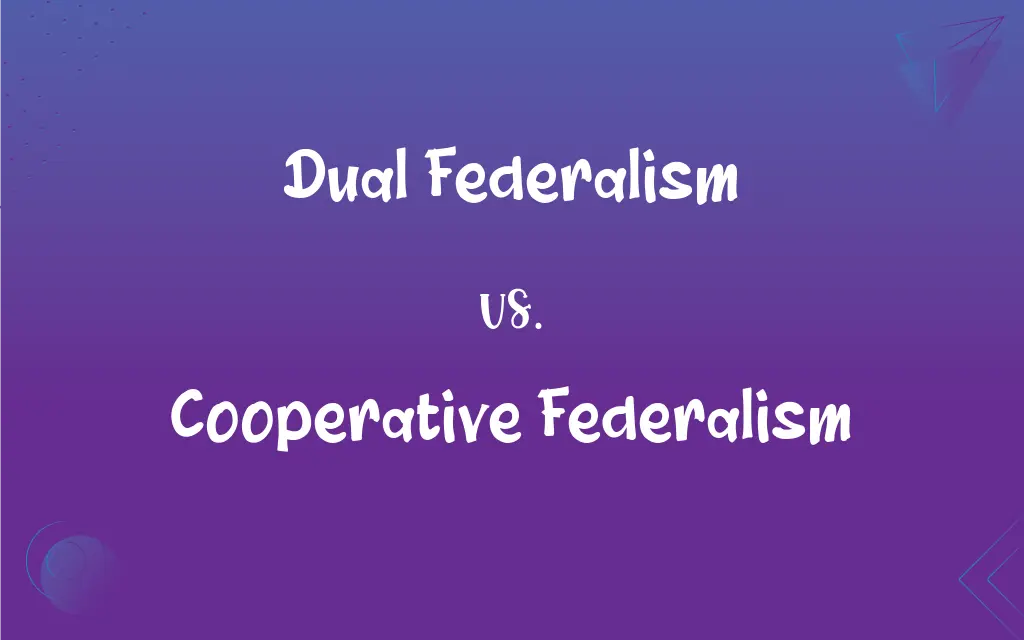Dual Federalism vs. Cooperative Federalism: What's the Difference?
Edited by Aimie Carlson || By Harlon Moss || Published on January 14, 2024
Dual federalism involves clear, separate powers between state and federal governments; cooperative federalism features overlapping, shared powers and collaboration.

Key Differences
Dual federalism, often termed 'layer cake' federalism, depicts a clear distinction between federal and state powers. In contrast, cooperative federalism, known as 'marble cake' federalism, involves intertwined responsibilities and cooperative action between the two levels.
In dual federalism, state and federal governments operate independently in their respective spheres. Cooperative federalism, however, sees them working together on various issues, sharing resources and responsibilities.
Dual federalism was predominant in the United States until the 1930s, focusing on a narrow interpretation of federal powers. Cooperative federalism emerged during the New Deal era, promoting a more collaborative approach between federal and state governments.
Under dual federalism, policies and programs are distinctly separate between the states and the federal government. In cooperative federalism, there's a blend and overlap of policies, often leading to joint programs.
Dual federalism supports the idea of a limited federal government, whereas cooperative federalism advocates for a stronger federal role, particularly in areas like healthcare, education, and transportation.
ADVERTISEMENT
Comparison Chart
Power Distribution
Clearly divided between state and federal
Overlapping and shared powers
Operational Approach
Independent operation of state and federal
Collaboration between state and federal
Historical Period
Predominant until the 1930s
Emerged during the New Deal era
Policy Implementation
Separate state and federal policies
Jointly developed and implemented policies
View on Federal Government
Supports limited federal role
Advocates for stronger federal involvement
ADVERTISEMENT
Dual Federalism and Cooperative Federalism Definitions
Dual Federalism
Dual federalism operates under the principle of two co-equal sovereigns.
In dual federalism, states have autonomy in areas not explicitly reserved for the federal government.
Cooperative Federalism
Cooperative federalism blurs the lines between state and federal roles.
In cooperative federalism, both federal and state governments play a role in healthcare.
Dual Federalism
Dual federalism is a political arrangement where state and federal governments have distinct and separate powers.
The U.S. Constitution originally established more clear lines of dual federalism.
Cooperative Federalism
Cooperative federalism is a concept where state and federal governments work collaboratively.
Cooperative federalism is evident in the joint funding of infrastructure projects.
Dual Federalism
Dual federalism represents a 'layer cake' model with clear divisions.
The distinct roles in dual federalism avoid the overlapping of state and federal laws.
Cooperative Federalism
Cooperative federalism is likened to a 'marble cake,' with intertwined responsibilities.
Environmental regulations often involve cooperative federalism, combining state and federal efforts.
Dual Federalism
Dual federalism supports the idea of states as "laboratories of democracy."
Dual federalism allows states to experiment with different policies without federal interference.
Cooperative Federalism
Cooperative federalism often involves shared funding, administration, and planning.
Federal grants to states are a common feature of cooperative federalism.
Dual Federalism
Dual federalism maintains a narrow interpretation of federal powers.
Under dual federalism, the federal government's role in education is minimal.
Cooperative Federalism
Cooperative federalism emerged in response to complex societal problems.
The New Deal policies are classic examples of cooperative federalism.
FAQs
What's a historical example of dual federalism?
The early years of the United States, prior to the New Deal.
What is the key principle of dual federalism?
It maintains a clear separation of state and federal powers.
Can states override federal law in dual federalism?
No, federal law is supreme, but states have wide latitude in their domains.
Is dual federalism still practiced today?
It's less prevalent, with more emphasis on cooperative federalism.
How does cooperative federalism handle policy making?
It involves joint state and federal involvement in policy making.
How do emergencies like natural disasters fit into these models?
They often require a cooperative federalism approach for effective response.
What impact does cooperative federalism have on local governments?
It often increases their involvement in federal initiatives.
Does cooperative federalism encourage innovation?
It can, through shared knowledge and resources between state and federal governments.
Are state governments more powerful in cooperative federalism?
They share power with the federal government rather than having more power.
Can dual federalism lead to inconsistencies between states?
Yes, as states have the freedom to implement distinct policies.
How do states' rights activists view cooperative federalism?
They often view it skeptically as it can dilute state sovereignty.
How does cooperative federalism affect federal grants?
It often leads to more conditional federal grants to states.
Does cooperative federalism reduce state sovereignty?
It transforms it, requiring more collaboration with the federal government.
How do courts interpret states' rights in dual federalism?
They often interpret them narrowly, adhering to constitutional divisions.
Does dual federalism offer more clear legal guidelines?
Yes, due to the distinct separation of powers.
Is one form of federalism better than the other?
It depends on the context and the specific policy area in question.
How does education policy differ under these systems?
Under dual federalism, states have more control; under cooperative, there's more federal involvement.
How does funding differ between these two forms of federalism?
Cooperative federalism often involves more shared funding mechanisms.
Can dual federalism lead to duplication of efforts?
Yes, as both state and federal governments may independently address the same issues.
Are environmental policies typically dual or cooperative?
They're usually cooperative, involving both state and federal regulations.
About Author
Written by
Harlon MossHarlon is a seasoned quality moderator and accomplished content writer for Difference Wiki. An alumnus of the prestigious University of California, he earned his degree in Computer Science. Leveraging his academic background, Harlon brings a meticulous and informed perspective to his work, ensuring content accuracy and excellence.
Edited by
Aimie CarlsonAimie Carlson, holding a master's degree in English literature, is a fervent English language enthusiast. She lends her writing talents to Difference Wiki, a prominent website that specializes in comparisons, offering readers insightful analyses that both captivate and inform.






































































